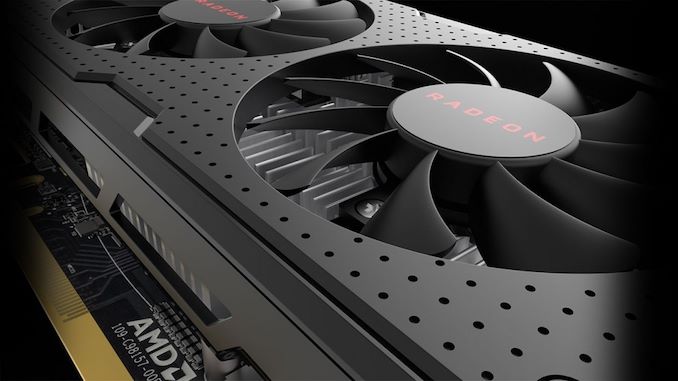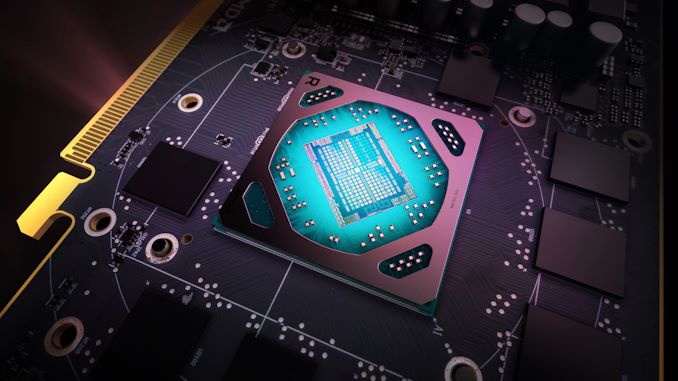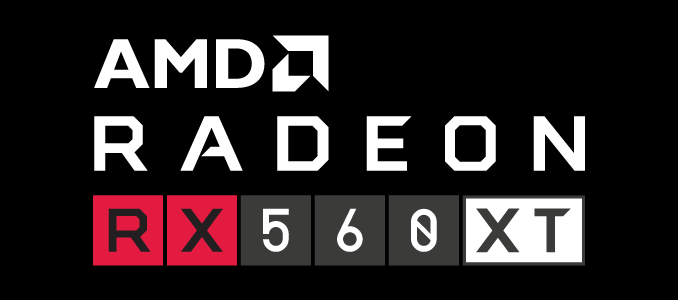AMD Launches China-only Radeon RX 560 XT
by Ryan Smith on March 12, 2019 9:00 PM EST- Posted in
- GPUs
- AMD
- Radeon
- Polaris
- Radeon RX 500

This evening – or rather this morning in China – AMD is rolling out a new mid-to-entry level Radeon RX video card. Dubbed the Radeon RX 560 XT, the new part is a lower-tier Polaris 10-based card that’s designed to fill the gap between the RX 560 and the RX 570 in the Chinese market. This new SKU will only be sold in China – don’t expect to see it come to North America – with AMD’s close partner Sapphire being the sole vender of the card.
By the numbers, the Radeon RX 560 XT is a relatively straightforward cutting down of the Radeon RX 570, itself a cut-down Polaris 10 SKU. Relative to the 570, the 560 XT drops another 4 CUs, bringing it down to 28 CUs. Past that, the clockspeeds have also taken a hit; the 560 XT will top out at just 1073MHz for the boost clock, instead of 1244MHz like its fuller-fledged 570 sibling. So for shader and texture performance, it will deliver around 75% of the throughput of the RX 570.
| AMD Radeon RX 500 Series Specification Comparison (China) | ||||||
| AMD Radeon RX 580 2048SP | AMD Radeon RX 570 | AMD Radeon RX 560 XT | AMD Radeon RX 560 | |||
| Compute Units | 32 CUs (2048 SPs) |
32 CUs (2048 SPs) |
28 CUs (1792 SPs) |
14/16 CUs (896/1024 SPs) |
||
| Texture Units | 128 | 112 | 56/64 | |||
| ROPs | 32 | 32 | 16 | |||
| Base Clock | 1168 MHz | 1168 MHz | 973 MHz | <=1175MHz | ||
| Boost Clock | 1284 MHz | 1244 MHz | 1073 MHz | <=1275MHz | ||
| Memory Clock | 7Gbps GDDR5 | 6.6Gbps GDDR5 | 7Gbps GDDR5 | |||
| Memory Bus Width | 256-bit | 128-bit | ||||
| VRAM | 4GB or 8GB | 2GB or 4GB | ||||
| Transistor Count | 5.7 billion | 3 billion | ||||
| Typical Board Power | 150 W | 150 W | 60-80W | |||
| Manufacturing Process | GloFo 14nm | |||||
| Architecture | GCN 4 | |||||
| GPU | Polaris 10 | Polaris 11 | ||||
| Launch Date | 2018/10/15 | 2017/04/18 | 2019/3/13 | 2017/05 | ||
Meanwhile, although the card is taking a hit on the CU count, AMD has confirmed the card is retaining Polaris 10’s full 256-bit memory bus. This will be paired with GDDR5 running at 6.6Gbps, so there is a small step down in bandwidth. But overall it conserves most (~94%) of RX 570’s bandwidth, ensuring the card doesn’t end up bandwidth-starved as a theoretical 128-bit Polaris 10 would be. In either case, Sapphire will be offering cards with both 4GB and 8GB of VRAM, so there will be an 8GB premium option available for buyers who are nervous about 4GB cards coming up short.
AMD has also confirmed that the new product retains Polaris 10's full 32 ROP backend, so its pixel throughput is only slightly diminished overall by the reduced clockspeeds (~86%). That AMD would go with 32 ROPs was not a given; AMD’s ROPs are not fully coupled to their memory controller, so they can scale them independently of the memory controller width.
Typical Board Power (TBP) is also unchanged from the Radeon RX 570, with AMD holding it at 150W. While practical power consumption should be reduced some anyhow thanks to the fewer CUs and the lower clockspeeds, officially at least AMD isn't making any promises.
Looking at the bigger picture, the RX 560 XT is designed to fill the gap between the RX 560 and RX 570 in AMD’s lineup, as the latter offers almost 2x (or more) of the performance of the RX 560 in almost every way. In practice I would expect a card with these specifications to pull a lot closer to the RX 570 than the RX 560, but we’ll have to see where real-world performance ends up. Meanwhile, besides being priced between the two cards, AMD wasn’t able to give me any more specific details on pricing, so I’d expect to see this priced somewhere north of 1000 CNY.
Overall, AMD is no stranger to shipping China-specific mid-range and entry-level video card SKUs. Last fall the company started offering the Radeon RX 580 2048SP in China, so this will be the second regionally-limited Polaris 10 SKU that the company has put out. This is a practice that has been growing in popularity overall for both GPU vendors; the Chinese market as a whole is even more heavily weighted towards low-end and mid-range cards than western markets as fewer customers can afford to buy the high-end halo parts, so both vendors have been favoring creating smaller steps between products in this region. Similarly, being a humongous customer base within a single country, it allows AMD and NVIDIA to sell smaller volume parts – particularly salvaged GPUs that would otherwise go to waste – without the hassle of launching and supplying the product across multiple regions.
Source: AMD














22 Comments
View All Comments
Ej24 - Tuesday, March 12, 2019 - link
Depending on the ROP situation it really doesn't sound that bad. Kinda wish they'd offer it here in the US. Though the 570 is very competitively priced as it isstanleyipkiss - Wednesday, March 13, 2019 - link
As long as it's got an XT moniker, then I don't mind and I'm sure few people will. They could have called it the 570 and left consumers in the dark about which one is the slower one (remember the nvidia DDR4 GT 1030?).qap - Wednesday, March 13, 2019 - link
You don't have to go that far to find example of confusing name. RX560 was originaly launched as 1024SP part and AMD sneaked 896SP version later (look at specification comparison table...)Ryan Smith - Wednesday, March 13, 2019 - link
AMD has since confirmed that it is in fact 32 ROPs. So it's a 570 with 75% the shader throughput, 85% the ROP throughput, and 94% of the memory bandwidth.BigMamaInHouse - Wednesday, March 13, 2019 - link
Maybe it's just RX 570 with disabled CU in bios so they can get rid of the stock without lowering RX 570 price?Hul8 - Wednesday, March 13, 2019 - link
Could also be that the chips used in these are lower quality - can't clock as high as regular RX 570s without using inordinate amounts of power. Add the small number of chips with less than 32 functional CUs in the pile. You get a number of GPUs that can run 28 CUs (instead of 32), at lowered clocks, at the same power consumption as an RX 570.DanNeely - Wednesday, March 13, 2019 - link
A cut down model launched late in the product cycle generally is the chipmaker using up their dud dies ahead of their next product launch (Navi). Launching in only one region means they don't have a lot of dies that fit in the bucket and can't support a global launch.It also means that like the weird 1060's (massively cutdown GP104 instead of GP106, and 5GB ram instead of 6) Nvidia released late last year to clear out their dud Pascal dies, it's unlikely to cross any review desks unless someone goes and orders one on the grey market.
Cellar Door - Wednesday, March 13, 2019 - link
Yup, we will never actually hear about these cards other then random articles such as these. Kinda makes you wonder why even bother writing these articles. Its a China specific card, that no one will ever see anywhere else in the world. It might as well not exist.mode_13h - Wednesday, March 13, 2019 - link
Why are they so reluctant to use the last digit for anything? What's wrong with calling it RX 565? Likewise, the RX 580 2048SP could've just been the RX 575.Retycint - Wednesday, March 13, 2019 - link
Exactly. It's pretty strange, considering that they had the R9 285 which was between the 290 and 280x